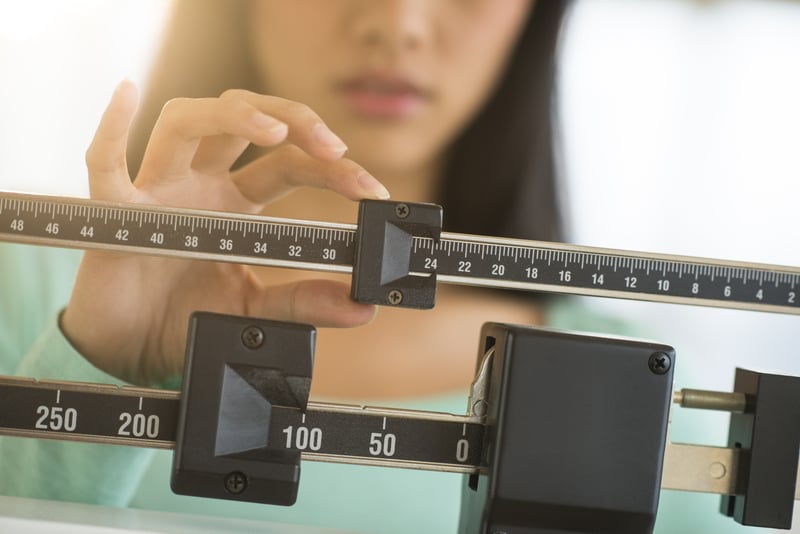Ditch the Scale—Use These 3 Health Measurements Instead

Having just been diagnosed as “overweight” during my yearly physical has really taken a toll on me. According to the BMI (body mass index) chart, which has become the favorite health measurement by physicians far and wide, I need to shed a few LBs. BMI is calculated by using a person’s height and weight. Unfortunately, this does not take into account any of the PRs (personal records) I have racked up this year in my garage gym, the endless miles I walk daily with my new puppy, or the exhausting task of keeping up with two very active elementary-school-aged children.
BMI poorly discriminates between excess adipose (i.e., fat) tissue and high lean muscle mass and does not account for body fat distribution, so I am taking this new diagnosis with a grain of salt.
I will admit that during this pandemic, pajamas and yoga pants have replaced my jeans and shorts. However, as I slowly started to integrate buttons and zippers back into my wardrobe, I found they were actually a little loose. So, what gives?
Having a love-hate relationship with the scale is one of the leading causes of anxiety, and not just among women. Obsessing over our weight plagues both sexes—and hopping on the scale every week or even every day is something most of us are guilty of (myself included). But why have we allowed this health measurement to dictate our lives or, at the very least, our moods for the day? Why do we place so much of our value on the fluctuation of our overall body mass?
It doesn’t have to be this way, and it shouldn’t!
The Value of Non-Scale Victories
If you are health-conscious and want to prove to yourself that all of your healthy choices are making an impact on your health and wellness, there are far better ways to keep track of your progress (or lack thereof). Non-scale victories are always one of my favorite ways. You can also gauge your progress by keeping a journal of your activity—being mindful of the duration, ability, and strength levels—striving to make improvements.
For those of you who need to see the data, or if you are looking for a more scientific means, there is a couple health measurements you should be using. Using—not obsessing over!
Health Measurements You Should Be Using
I have often harped on taking body measurements as an ideal way to assess your overall health and wellness, and I believe it is a good idea to document a few areas throughout the year (i.e., neck, arms, waist, hips, legs). If this seems tedious, perhaps tracking just your waist circumference is a little easier to manage.
1. Waist Circumference Measurements
The generally accepted circumferences are:
- Men: < 94 cm or <37 in
- Women: < 80 cm or <31.5 in
While tracking your body fat distribution with solely one measurement is a helpful tool to identify possible health risks that can identify people who are at increased risk for obesity-related disease, along with potential heart health risk, is this really the most ideal? Probably not as a stand-alone measurement. However, some studies would disagree with me. 1 One such study pinned WC (waist circumference), WHtR (waist to height ratio), WHR (waist to hip ratio), and BMI against one another with a more favorable obesity predictor coming from simply measuring a person’s waist.
2. Waist-to-Hip Ratio
Some experts would argue that adding a second component to this measurement is a better health indicator. While somewhat outdated, these folks maintain that measuring waist and hips is most acceptable.
Waist-to-hip ratio:
- Men: < 0.90
- Women: < 0.85
For example, if you are 5’5” and your waist is 30 inches and your hips are 36 inches, you would measure .83, which is considered good. But is it really? While I agree it is helpful to have a second measurement to add to the equation, as opposed to just measuring your waist circumference, I can’t help but feel there may be an even better way.
3. Waist-to-Height Ratio
Last but not least and arguably my favorite method is calculating your waist and your height ratio.
Waist-to-height ratio:
- < 0.59 (for both men and women)
For example, if you are 5’5” and have a waist circumference of 30 inches, your waist to height ratio would be .46, which is good. Several studies have touted this to be a much better indicator, one of which did extensive research putting five methods head to head against one another. 2
This study determined that the waist-to-height health measurements are the best predictor of both body fat percentage and VAT mass (visceral adaptive tissue) in both men and women. By using only a piece of string, you can easily measure your height, then fold it in half and measure your waist. This eliminates having to measure both BMI and WC, which require taking into account age, sex, and ethnicity—none of which is needed for height-to-waist measurements.
Ditch the Scale — Use These Health Measurements Instead
Bottom line—you do not need a scale to tell you whether or not you are on the right path to optimal health and wellness. Just being mindful of a few key health measurements can identify potential health risks. If you have to unbutton your pants after a meal, or if you are having to make new holes on your belt, it may be time to reassess your plan.
If you need help in doing so, please reach out to one of the Coaches. That is what we are here for! We are here to help and are always happy to do so. To your health!






